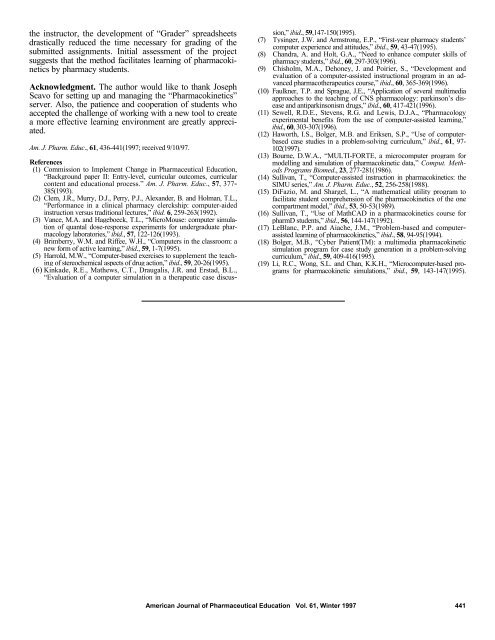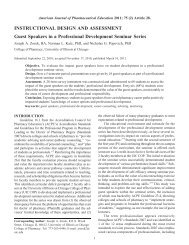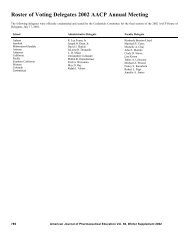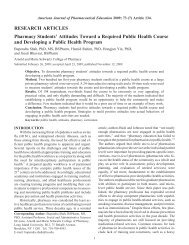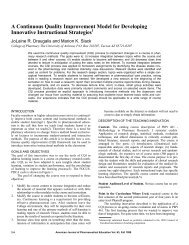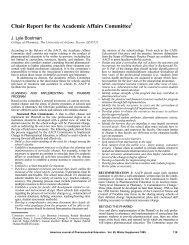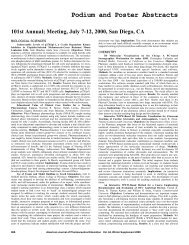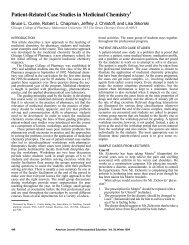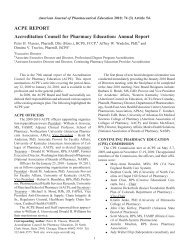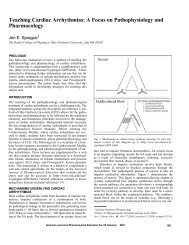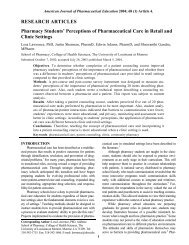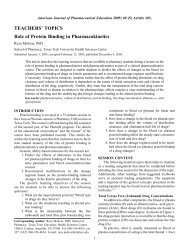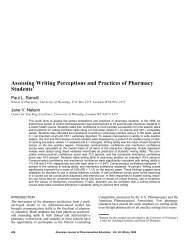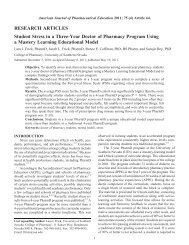View PDF - AJPE - The American Journal of Pharmaceutical Education
View PDF - AJPE - The American Journal of Pharmaceutical Education
View PDF - AJPE - The American Journal of Pharmaceutical Education
You also want an ePaper? Increase the reach of your titles
YUMPU automatically turns print PDFs into web optimized ePapers that Google loves.
the instructor, the development <strong>of</strong> “Grader” spreadsheets<br />
drastically reduced the time necessary for grading <strong>of</strong> the<br />
submitted assignments. Initial assessment <strong>of</strong> the project<br />
suggests that the method facilitates learning <strong>of</strong> pharmacokinetics<br />
by pharmacy students.<br />
Acknowledgment. <strong>The</strong> author would like to thank Joseph<br />
Scavo for setting up and managing the “Pharmacokinetics”<br />
server. Also, the patience and cooperation <strong>of</strong> students who<br />
accepted the challenge <strong>of</strong> working with a new tool to create<br />
a more effective learning environment are greatly appreciated.<br />
Am. J. Pharm. Educ., 61, 436-441(1997; received 9/10/97.<br />
References<br />
(1) Commission to Implement Change in <strong>Pharmaceutical</strong> <strong>Education</strong>,<br />
“Background paper II: Entry-level, curricular outcomes, curricular<br />
content and educational process.” Am. J. Pharm. Educ., 57, 377-<br />
385(1993).<br />
(2) Clem, J.R., Murry, D.J., Perry, P.J., Alexander, B. and Holman, T.L.,<br />
“Performance in a clinical pharmacy clerckship: computer-aided<br />
instruction versus traditional lectures,” ibid. 6, 259-263(1992).<br />
(3) Vance, M.A. and Hageboeck, T.L., “MicroMouse: computer simulation<br />
<strong>of</strong> quantal dose-response experiments for undergraduate pharmacology<br />
laboratories,” ibid., 57, 122-126(1993).<br />
(4) Brimberry, W.M. and Riffee, W.H., “Computers in the classroom: a<br />
new form <strong>of</strong> active learning,” ibid., 59, 1-7(1995).<br />
(5) Harrold, M.W., “Computer-based exercises to supplement the teaching<br />
<strong>of</strong> stereochemical aspects <strong>of</strong> drug action,” ibid., 59, 20-26(1995).<br />
(6) Kinkade, R.E., Mathews, C.T., Draugalis, J.R. and Erstad, B.L.,<br />
“Evaluation <strong>of</strong> a computer simulation in a therapeutic case discussion,”<br />
ibid., 59,147-150(1995).<br />
(7) Tysinger, J.W. and Armstrong, E.P., “First-year pharmacy students’<br />
computer experience and attitudes,” ibid., 59, 43-47(1995).<br />
(8) Chandra, A. and Holt, G.A., “Need to enhance computer skills <strong>of</strong><br />
pharmacy students,” ibid., 60, 297-303(1996).<br />
(9) Chisholm, M.A., Dehoney, J. and Poirier, S., “Development and<br />
evaluation <strong>of</strong> a computer-assisted instructional program in an advanced<br />
pharmacotherapeutics course,” ibid., 60, 365-369(1996).<br />
(10) Faulkner, T.P. and Sprague, J.E., “Application <strong>of</strong> several multimedia<br />
approaches to the teaching <strong>of</strong> CNS pharmacology: parkinson’s disease<br />
and antiparkinsonism drugs,” ibid., 60, 417-421(1996).<br />
(11) Sewell, R.D.E., Stevens, R.G. and Lewis, D.J.A., “Pharmacology<br />
experimental benefits from the use <strong>of</strong> computer-assisted learning,”<br />
ibid., 60, 303-307(1996).<br />
(12) Haworth, I.S., Bolger, M.B. and Eriksen, S.P., “Use <strong>of</strong> computerbased<br />
case studies in a problem-solving curriculum,” ibid., 61, 97-<br />
102(1997).<br />
(13) Bourne, D.W.A., “MULTI-FORTE, a microcomputer program for<br />
modelling and simulation <strong>of</strong> pharmacokinetic data,” Comput. Methods<br />
Programs Biomed., 23, 277-281(1986).<br />
(14) Sullivan, T., “Computer-assisted instruction in pharmacokinetics: the<br />
SIMU series,” Am. J. Pharm. Educ., 52, 256-258(1988).<br />
(15) DiFazio, M. and Shargel, L., “A mathematical utility program to<br />
facilitate student comprehension <strong>of</strong> the pharmacokinetics <strong>of</strong> the one<br />
compartment model,” ibid., 53, 50-53(1989).<br />
(16) Sullivan, T., “Use <strong>of</strong> MathCAD in a pharmacokinetics course for<br />
pharmD students,” ibid., 56, 144-147(1992).<br />
(17) LeBlanc, P.P. and Aiache, J.M., “Problem-based and computerassisted<br />
learning <strong>of</strong> pharmacokinetics,” ibid., 58, 94-95(1994).<br />
(18) Bolger, M.B., “Cyber Patient(TM): a multimedia pharmacokinetic<br />
simulation program for case study generation in a problem-solving<br />
curriculum,” ibid., 59, 409-416(1995).<br />
(19) Li, R.C., Wong, S.L. and Chan, K.K.H., “Microcomputer-based programs<br />
for pharmacokinetic simulations,” ibid., 59, 143-147(1995).<br />
<strong>American</strong> <strong>Journal</strong> <strong>of</strong> <strong>Pharmaceutical</strong> <strong>Education</strong> Vol. 61, Winter 1997 441


